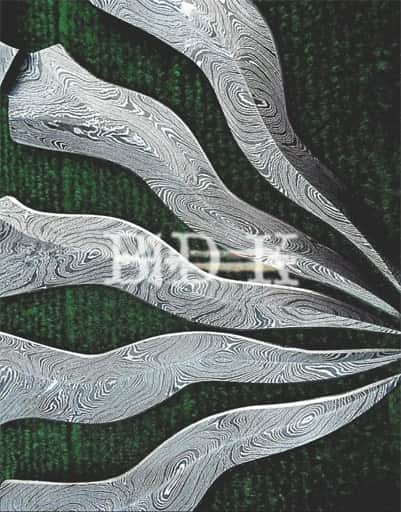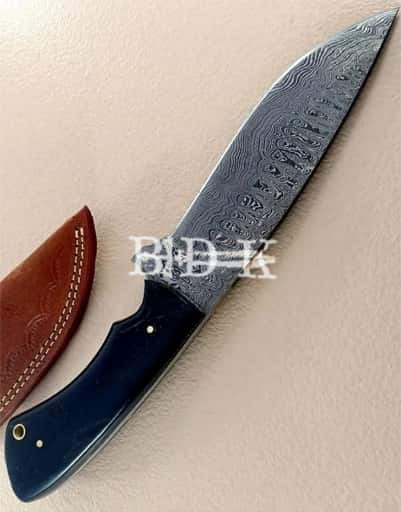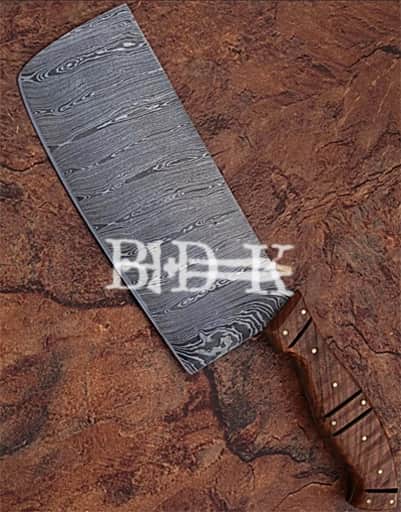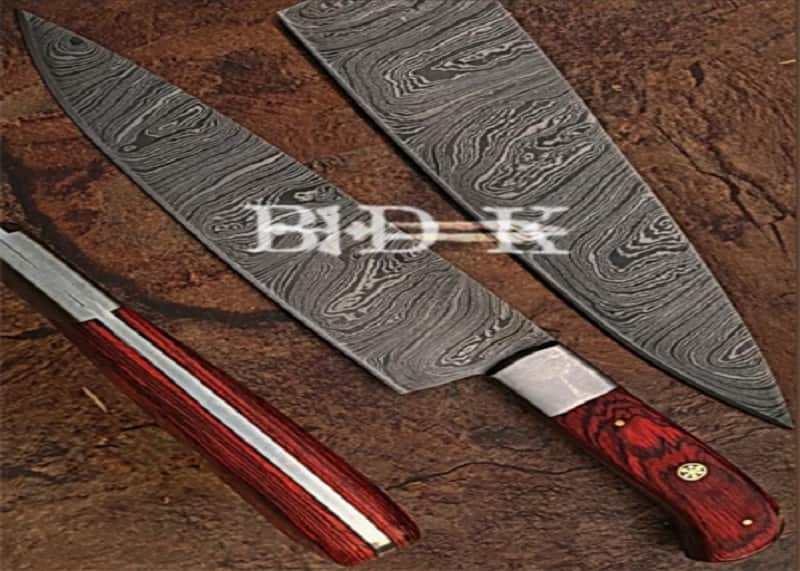Does Damascus Steel Rust is made from forge-welded layers of 15N20 Steel & 1075 steel? The 15N20 is Nickel steel & is what makes the stars of the pattern, whilst 1075 is Carbon steel & turns black when bitten.
When Heat-Treated & used in a blade this organisation holds an exceptional edge. The blade will gain a beautiful patina with Prolonged use as with any Carbon Steel-Based blade. The colour & character of the patina is decided by the kind of ingredients & food the blade is applied to cut. For example, cooked red meat forms a beautiful Blue-Grey patina that will be forward to anyone who has found heirloom Carving-Knives.
In this article, we at BestDamascussKnife will give you the guide on the Does Damascus Steel Rust. Is a guide of some of the great idea out there to assist you to make a great knife blade.
You Might Also Like ⇒
Best Pocket Knife for Kid
How To Test Knife Sharpness
How To Sharpen A Knife Without A Sharpener
Best Folding Knife Under 100
Cleaver Folding Knife
Best Japanese Knife Set
How Does Damascus Steel Rust on Your knives?

Does Damascus Steel Rust
Damascus steel rust is the outcome of the oxidation of iron & one of the most universally appreciated reasons for Rust-Spots on Kitchen-Steel knives is the postponed initiation to water. Any metal that carries iron, including steel, will bond with the oxygen bits found in water casting a layer of Iron-Oxide, or as we are aware it – rust.
If you’ve any profound scratches on your kitchen steel knife or scraped spots this is an excellent zone for rust to the frame. If you see any Damascus steel rust spots on your steel knife it is most useful to expel it as quickly as time charters to stay apart from any additional injury that may happen.
Three Simple Ways to Damascus Steel Remove Rust From Your knives

Damascus Steel Remove Rust
1. Normal Lemon Juice
Does Damascus Steel Rust, put some new Lemon-Juice into a glass or will section place your Damascus steel knives in the Lemon-Answer for a few moments & afterwards take them out. The destructive in the lemon squeeze slacken up the rust from the Damascus blade cutting edge which thus should make it significantly simpler to wash away those rust points.
2. Utilize a Potato
Damascus steel rust insane as this sounds it does work, take your Damascus knife & drive the Cutting-Edge inside an entire potato & leave it in the vegetable for a day or Medium-Term. Expel your Damascus knife blade from the potato & clean away the loosened rust spots. How Does Damascus Steel Rust this work? Basically; the Oxalic-Corrosive in the potatoes abandons the development of rust.
Have a go at Covering Your Damascus knife in Vinegar: A vinegar is located in each family unit & this Non-Harmful destructive works incredible at dislodging rust spots on your kitchen steel knife. Similarly as with various techniques place your kitchen Damascus knife Cutting-Edge into the vinegar & leave it to douse Medium-Term at that point take it out & clean the Damascus rust spots away. The greatest vinegar to use for this rust removing technique is apple sauce vinegar preferably of the white vinegar, while white-vinegar may work it’s not as compelling as gall juice vinegar.
3. Heating Soda Paste
Does Damascus Steel Rust, everybody has to cook Soft-Drink someplace gathering dirt on their kitchen shelves, also if not why not? It has various utilizations in the house. You have to take sufficient preparing Soft-Drink to blend in with water to body a glue that has a related thickness as toothpaste or just somewhat thicker.
Take you baking Soft-Drink blend & begin to use it to your Damascus Knife-Sharp end utilizing a Non-Grating scouring pad, plastic scrubby to carefully rub the affected zones of the Cutting-Edge; utilizing Damascus steel fleece can make about further harm. Rehash the equal number of times as necessary until the rust points have gone.
How To Care For Damascus Steel Knife?
Damascus knife patterns are created by forging or “Folding” Stainless-Steels & softer High-Carbon steel. To bring out the design, the blades do place in an “Acid-Bath.” During this method, the more corrosive High-Carbon Steel has drained away, leaving following unique patterns. We then “Seal” the blades using a Museum-Grade wax layer.

Damascus Steel Knife
Tips: Four Damascus Steel Care
1. Keep Damascus Clean & Free of Moisture
Does Damascus Steel Rust, blades will need more study, since the high carbon metals that support create the design present a high risk of corrosion. We suggest wiping the blade after it has got into contact with damp & especially acidic stuff like Apples, Steak, or Fingers.
2. Spot Clean Rust
If your knives are in a humid atmosphere, it will rust. The best method to quickly direct rust is to spot clean your blade with Soft-Scrub & a Q-Tip when you initial see it appear. If you can see pitting on the knife, it is particularly vital to keep those points clean so that more stuff isn’t removed.
3. Protect The Pattern
Apply a small number of WD-40 or a Quality-Oil when the blade is fully dry to help protect versus fading & moisture. Our Damascus is chemically bonded with Stainless-Steel & various Softer-Metals, so there is no requirement to worry about flaking or chipping, but the knife pattern may still wear over time from routine use.
4. Maintain the edge
Does Damascus Steel Rust, will maintain its point for quite a while, but it will dull quicker than our regular blade. We recommend keeping the edge with the Spyderco-Triangle-Sharpmaker.
After Use:
- Rinse washed under Running-Water & Wipe-Dry with a clean cloth
- Lightly oil using Food-Safe Oil
- Store in a desert place
While your knife blade is still producing a patina, it is a great idea to quickly clear the blade down before going on to a food arrangement task, not including the knife.
1. Oiling
A common error when Oiling a knife blade is to use something like Olive-Oil that will go stale. We recommend mineral oil, as it is Food-Safe, Cheap, & Readily Available.
2. Washing
Several people buy new Damascus steel knife approach cleaning their blades with shock. Washing your knife is Honest: Rinse it under running water, wipe it with a mildly soapy Dish-Sponge, rinse it again & Wipe-Dry. If you are familiar with the term “Bachelor-Wash”, this is all it needs.
3. Refreshing the Pattern
The Damascus Knife pattern will decrease with use; this is normal & Easy-To-Rectify. Hot black Instant-Coffee (Cheap, Nasty, & mixed at a rate that would hit a Large-Animal) is a mild etchant that we practice as the Final-Stage of our Damascus drawing process. It is an element of our process that gives most to the darkness of the pattern.
Here’s How to Refresh Your Blades:
- Brew a bunch of the most affordable & nastiest black instant drink you can take your hands on. You will need sufficient to cover the blade in.
- Wash the blade, then completely wipe it down with methylated courage to Remove-Oils & contaminants
- Immerse the knife blade in the prepared coffee, roasting the coffee back up if it’s left cold (Heat-Increases the rate of response). Take care to evade getting beverage on the handle.
- Expect the method to take anyplace btw 15-Minutes & an hour. Check the blade every 15-Minutes by killing it from the coffee & enabling the coffee to Drip-Off. Don’t touch or wash down the blade at any spot.
- When the wanted results have been done, remove the knife blade from the drink then wash as normal ere Oiling & Storing.

